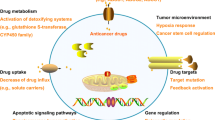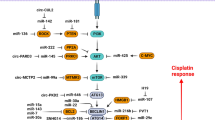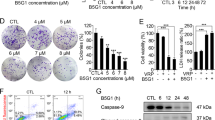Abstract
Multidrug resistance (MDR) is a significant cause of tumor treatment failure. Accumulating evidence suggests that autophagy plays a significant role in the development of MDR. Autophagy is a conserved mechanism that maintains tumor homeostasis by removing damaged mitochondria. However, the specific regulatory mechanism is unclear. Here, we summarize recent studies on the role of autophagy in the development of MDR and the initiation of mitophagy by Bcl-2-associated athanogene (BAG) family proteins. Additionally, this mini-review emphasizes the regulatory role of BAG family proteins, which maintain mitochondrial homeostasis by regulating the PINK1/Parkin pathway. Elucidation of the regulatory mechanisms of mitophagy may foster the development of clinical therapeutic strategies for MDR tumors.



Similar content being viewed by others
References
Elzahabi HSA, Nossier ES, Khalifa NM, Alasfoury RA, El-Manawaty MA. Anticancer evaluation and molecular modeling of multi-targeted kinase inhibitors based pyrido[2,3-d]pyrimidine scaffold. J Enzym Inhib Med Ch. 2018;33(1):546–57.
Levine B, Kroemer G. Biological functions of autophagy genes: a disease perspective. Cell. 2019;176(1–2):11–42. https://doi.org/10.1016/j.cell.2018.09.048.
Strappazzon F, Vietri-Rudan M, Campello S, Nazio F, Florenzano F, Fimia GM, Piacentini M, Levine B, Cecconi F. Mitochondrial BCL-2 inhibits AMBRA1-induced autophagy. EMBO J. 2011;30(7):1195–208. https://doi.org/10.1038/emboj.2011.49.
Widden H, Kaczmarczyk A, Whitaker RH, Placzek WJ. MCL1 binds and negatively regulates the transcriptional function of tumor suppressor p73. Cancer Res. 2019;79:13.
Singh R, Letai A, Sarosiek K. Regulation of apoptosis in health and disease: the balancing act of BCL-2 family proteins. Nat Rev Mol Cell Bio. 2019;20(3):175–93.
Robey RW, Pluchino KM, Hall MD, Fojo AT, Bates SE, Gottesman MM. Revisiting the role of ABC transporters in multidrug-resistant cancer. Nat Rev Cancer. 2018;18(7):452–64.
Alfarouk KO, Stock CM, Taylor S, Walsh M, Muddathir AK, Verduzco D, Bashir AHH, Mohammed OY, Elhassan GO, Harguindey S, Reshkin SJ, Ibrahim ME, Rauch C. Resistance to cancer chemotherapy: failure in drug response from ADME to P-gp. Cancer Cell Int. 2015. https://doi.org/10.1186/s12935-015-0221-1.
Youn YS, Bae YH. Perspectives on the past, present, and future of cancer nanomedicine. Adv Drug Deliv Rev. 2018;130:3–11. https://doi.org/10.1016/j.addr.2018.05.008.
Behl C. Breaking BAG: the co-chaperone BAG3 in health and disease. Trends Pharmacol Sci. 2016;37(8):672–88. https://doi.org/10.1016/j.tips.2016.04.007.
Rauch JN, Zuiderweg ER, Gestwicki JE. Non-canonical interactions between heat shock cognate protein 70 (Hsc70) and Bcl2-associated anthanogene (BAG) co-chaperones are important for client release. J Biol Chem. 2016;291(38):19848–57. https://doi.org/10.1074/jbc.M116.742502.
Gurusamy N, Lekli I, Gherghiceanu M, Popescu LM, Das DK. BAG-1 induces autophagy for cardiac cell survival. Autophagy. 2009;5(1):120–1. https://doi.org/10.4161/auto.5.1.7303.
Rosati A, Graziano V, De Laurenzi V, Pascale M, Turco MC. BAG3: a multifaceted protein that regulates major cell pathways. Cell Death Dis. 2011;2: e141. https://doi.org/10.1038/cddis.2011.24.
Behl C. BAG3 and friends: co-chaperones in selective autophagy during aging and disease. Autophagy. 2011;7(7):795–8. https://doi.org/10.4161/auto.7.7.15844.
Amaravadi R, Kimmelman AC, White E. Recent insights into the function of autophagy in cancer. Genes Dev. 2016;30(17):1913–30. https://doi.org/10.1101/gad.287524.116.
Zhu J, Thompson CB. Metabolic regulation of cell growth and proliferation. Nat Rev Mol Cell Biol. 2019;20(7):436–50. https://doi.org/10.1038/s41580-019-0123-5.
Yan XY, Zhong XR, Yu SH, Zhang LC, Liu YN, Zhang Y, Sun LK, Su J. p62 aggregates mediated caspase 8 activation is responsible for progression of ovarian cancer. J Cell Mol Med. 2019;23(6):4030–42. https://doi.org/10.1111/jcmm.14288.
Liu X, Mi X, Wang Z, Zhang M, Hou J, Jiang S, Wang Y, Chen C, Li W. Ginsenoside Rg3 promotes regression from hepatic fibrosis through reducing inflammation-mediated autophagy signaling pathway. Cell Death Dis. 2020. https://doi.org/10.1038/s41419-020-2597-7.
Anwanwan D, Singh SK, Singh S, Saikam V, Singh R. Challenges in liver cancer and possible treatment approaches. Bba-Rev Cancer. 2020;1873:188314.
Sun Y, Yao X, Zhang Q-J, Zhu M, Liu Z-P, Ci B, Xie Y, Carlson D, Rothermel BA, Sun Y, Levine B, Hill JA, Wolf SE, Minei JP, Zang QS. Beclin-1-dependent autophagy protects the heart during sepsis. Circulation. 2018;138(20):2247–62. https://doi.org/10.1161/circulationaha.117.032821.
Swiader A, Nahapetyan H, Faccini J, D’Angelo R, Mucher E, Elbaz M, Boya P, Vindis C. Mitophagy acts as a safeguard mechanism against human vascular smooth muscle cell apoptosis induced by atherogenic lipids. Oncotarget. 2016;7(20):28821–35. https://doi.org/10.18632/oncotarget.8936.
Kazlauskaite A, Kondapalli C, Gourlay R, Campbell DG, Ritorto MS, Hofmann K, Alessi DR, Knebel A, Trost M, Muqit MMK. Parkin is activated by PINK1-dependent phosphorylation of ubiquitin at Ser(65). Biochem J. 2014;460:127–39.
Shiba-Fukushima K, Arano T, Matsumoto G, Inoshita T, Yoshida S, Ishihama Y, Ryu KY, Nukina N, Hattori N, Imai Y. Phosphorylation of mitochondrial polyubiquitin by PINK1 promotes parkin mitochondrial tethering. Plos Genet. 2014. https://doi.org/10.1371/journal.pgen.1004861.
Koyano F, Okatsu K, Kosako H, Tamura Y, Go E, Kimura M, Kimura Y, Tsuchiya H, Yoshihara H, Hirokawa T, Endo T, Fon EA, Trempe JF, Saeki Y, Tanaka K, Matsuda N. Ubiquitin is phosphorylated by PINK1 to activate parkin. Nature. 2014;510(7503):162.
Martinou JC, Youle RJ. Mitochondria in apoptosis: Bcl-2 family members and mitochondrial dynamics. Dev Cell. 2011;21(1):92–101. https://doi.org/10.1016/j.devcel.2011.06.017.
Lynes EM, Bui M, Yap MC, Benson MD, Schneider B, Ellgaard L, Berthiaume LG, Simmen T. Palmitoylated TMX and calnexin target to the mitochondria-associated membrane. EMBO J. 2012;31(2):457–70.
Sebti S, Prebois C, Perez-Gracia E, Bauvy C, Desmots F, Pirot N, Gongora C, Bach AS, Hubberstey AV, Palissot V, Berchem G, Codogno P, Linares LK, Liaudet-Coopman E, Pattingre S. BAG6/BAT3 modulates autophagy by affecting EP300/p300 intracellular localization. Autophagy. 2014;10(7):1341–2. https://doi.org/10.4161/auto.28979.
Alakhova DY, Rapoport NY, Batrakova EV, Timoshin AA, Li S, Nicholls D, Alakhov VY, Kabanov AV. Differential metabolic responses to pluronic in MDR and non-MDR cells: a novel pathway for chemosensitization of drug resistant cancers. J Control Release. 2010;142(1):89–100. https://doi.org/10.1016/j.jconrel.2009.09.026.
Nobili S, Lapucci A, Landini I, Coronnello M, Roviello G, Mini E. Role of ATP-binding cassette transporters in cancer initiation and progression. Semin Cancer Biol. 2020;60:72–95. https://doi.org/10.1016/j.semcancer.2019.08.006.
Jing X, Yang F, Shao C, Wei K, Xie M, Shen H, Shu Y. Role of hypoxia in cancer therapy by regulating the tumor microenvironment. Mol Cancer. 2019;18(1):157. https://doi.org/10.1186/s12943-019-1089-9.
Yang ML, Li HR, Li YR, Ruan Y, Quan CS. Identification of genes and pathways associated with MDR in MCF-7/MDR breast cancer cells by RNA-seq analysis. Mol Med Rep. 2018;17(5):6211–26. https://doi.org/10.3892/mmr.2018.8704.
Donmez Y, Gunduz U. Reversal of multidrug resistance by small interfering RNA (siRNA) in doxorubicin-resistant MCF-7 breast cancer cells. Biomed Pharmacother. 2011;65(2):85–9. https://doi.org/10.1016/j.biopha.2010.12.007.
Clay AT, Lu PH, Sharom FJ. Interaction of the P-glycoprotein multidrug transporter with sterols. Biochemistry. 2015;54(43):6586–97. https://doi.org/10.1021/acs.biochem.5b00904.
Kartal-Yandim M, Adan-Gokbulut A, Baran Y. Molecular mechanisms of drug resistance and its reversal in cancer. Crit Rev Biotechnol. 2016;36(4):716–26. https://doi.org/10.3109/07388551.2015.1015957.
Reed JC. Bcl-2 on the brink of breakthroughs in cancer treatment. Cell Death Differ. 2018;25(1):3–6. https://doi.org/10.1038/cdd.2017.188.
McNicholas K, MacGregor MN, Gleadle JM. In order for the light to shine so brightly, the darkness must be present-why do cancers fluoresce with 5-aminolaevulinic acid? Br J Cancer. 2019;121(8):631–9. https://doi.org/10.1038/s41416-019-0516-4.
Ko SH, Gonzalez G, Liu Z, Chen L. Axon injury-induced autophagy activation is impaired in a C. elegans model of tauopathy. Int J Mol Sci. 2020. https://doi.org/10.3390/ijms21228559.
Liang B, Liu X, Liu Y, Kong D, Liu X, Zhong R, Ma S. Inhibition of autophagy sensitizes MDR-phenotype ovarian cancer SKVCR cells to chemotherapy. Biomed Pharmacother. 2016;82:98–105. https://doi.org/10.1016/j.biopha.2016.04.054.
Green DR, Levine B. To be or not to be? How selective autophagy and cell death govern cell fate. Cell. 2014;157(1):65–75. https://doi.org/10.1016/j.cell.2014.02.049.
Levy JMM, Thorburn A. Autophagy in cancer: moving from understanding mechanism to improving therapy responses in patients. Cell Death Differ. 2020;27(3):843–57. https://doi.org/10.1038/s41418-019-0474.
Huang Q, Liu Y, Zhang S, Yap YT, Li W, Zhang D, Gardner A, Zhang L, Song S, Hess RA, Zhang Z. Autophagy core protein ATG5 is required for elongating spermatid development, sperm individualization and normal fertility in male mice. Autophagy. 2020. https://doi.org/10.1080/15548627.2020.1783822.
Kapadia M, De Snoo ML, Kalia LV, Kalia SK. Regulation of Parkin-dependent mitophagy by Bcl-2-associated athanogene (BAG) family members. Neural Regen Res. 2021;16(4):684–5. https://doi.org/10.4103/1673-5374.295330.
Aveic S, Tonini GP. Resistance to receptor tyrosine kinase inhibitors in solid tumors: can we improve the cancer fighting strategy by blocking autophagy? Cancer Cell Int. 2016;16:62. https://doi.org/10.1186/s12935-016-0341-2.
Rorke S, Murphy S, Khalifa M, Chernenko G, Tang SC. Prognostic significance of BAG-1 expression in nonsmall cell lung cancer. Int J Cancer. 2001;95(5):317–22. https://doi.org/10.1002/1097-0215(20010920)95:5%3c317::aid-ijc1055%3e3.0.co;2-j.
Giridhar KV, Sosa CP, Hillman DW, Sanhueza C, Dalpiaz CL, Costello BA, Quevedo FJ, Pitot HC, Dronca RS, Ertz D, Cheville JC, Donkena KV, Kohli M. Whole blood mRNA expression-based prognosis of metastatic renal cell carcinoma. Int J Mol Sci. 2017. https://doi.org/10.3390/ijms18112326.
Huang B, Zhou H, Lang X, Liu Z, Xiong F, Wang S. Expression of BAG-1 is closely related to cell differentiation and TNM stage in esophageal cancer and its downregulation inhibits the proliferation and invasion of human esophageal carcinoma cells. Oncol Rep. 2014;32(4):1441–6. https://doi.org/10.3892/or.2014.3356.
Kilbas PO, Akcay IM, Doganay GD, Arisan ED. Bag-1 silencing enhanced chemotherapeutic drug-induced apoptosis in MCF-7 breast cancer cells affecting PI3K/Akt/mTOR and MAPK signaling pathways. Mol Biol Rep. 2019;46(1):847–60. https://doi.org/10.1007/s11033-018-4540-x.
Papadakis E, Robson N, Yeomans A, Bailey S, Laversin S, Beers S, Sayan AE, Ashton-Key M, Schwaiger S, Stuppner H, Troppmair J, Packham G, Cutress R. A combination of trastuzumab and BAG-1 inhibition synergistically targets HER2 positive breast cancer cells. Oncotarget. 2016;7(14):18851–64. https://doi.org/10.18632/oncotarget.7944.
Liu S, Ren B, Gao H, Liao S, Zhai YX, Li S, Su XJ, Jin P, Stroncek D, Xu Z, Zeng Q, Li Y. Over-expression of BAG-1 in head and neck squamous cell carcinomas (HNSCC) is associated with cisplatin-resistance. J Transl Med. 2017;15(1):189. https://doi.org/10.1186/s12967-017-1289-2.
Collard TJ, Urban BC, Patsos HA, Hague A, Townsend PA, Paraskeva C, Williams AC. The retinoblastoma protein (Rb) as an anti-apoptotic factor: expression of Rb is required for the anti-apoptotic function of BAG-1 protein in colorectal tumour cells. Cell Death Dis. 2012;3: e408. https://doi.org/10.1038/cddis.2012.142.
Yoshino K, Motoyama S, Koyota S, Shibuya K, Usami S, Maruyama K, Saito H, Minamiya Y, Sugiyama T, Ogawa J. IGFBP3 and BAG1 enhance radiation-induced apoptosis in squamous esophageal cancer cells. Biochem Biophys Res Commun. 2011;404(4):1070–5. https://doi.org/10.1016/j.bbrc.2010.12.115.
Ke DS, Ji LM, Wang Y, Fu XM, Chen JY, Wang F, Zhao DB, Xue Y, Lan XH, Hou JM. JNK1 regulates RANKL-induced osteoclastogenesis via activation of a novel Bcl-2-beclin1-autophagy pathway. FASEB J. 2019;33(10):11082–95. https://doi.org/10.1096/fj.201802597RR.
Turk M, Tatli O, Alkan HF, Ozfiliz Kilbas P, Alkurt G, Dinler Doganay G. Co-chaperone bag-1 plays a role in the autophagy-dependent cell survival through beclin 1 interaction. Molecules. 2021. https://doi.org/10.3390/molecules26040854.
Sun J, Pan LM, Chen LB, Wang Y. LncRNA XIST promotes human lung adenocarcinoma cells to cisplatin resistance via let-7i/BAG-1 axis. Cell Cycle. 2017;16(21):2100–7. https://doi.org/10.1080/15384101.2017.1361071.
Millar EK, Anderson LR, McNeil CM, O’Toole SA, Pinese M, Crea P, Morey AL, Biankin AV, Henshall SM, Musgrove EA, Sutherland RL, Butt AJ. BAG-1 predicts patient outcome and tamoxifen responsiveness in ER-positive invasive ductal carcinoma of the breast. Br J Cancer. 2009;100(1):123–33. https://doi.org/10.1038/sj.bjc.6604809.
Mariotto E, Viola G, Zanon C, Aveic S. A BAG’s life: every connection matters in cancer. Pharmacol Ther. 2020;209: 107498. https://doi.org/10.1016/j.pharmthera.2020.107498.
Staibano S, Mascolo M, Di Benedetto M, Vecchione ML, Ilardi G, Di Lorenzo G, Autorino R, Salerno V, Morena A, Rocco A, Turco MC, Morelli E. BAG3 protein delocalisation in prostate carcinoma. Tumour Biol. 2010;31(5):461–9. https://doi.org/10.1007/s13277-010-0055-3.
Romano MF, Festa M, Petrella A, Rosati A, Pascale M, Bisogni R, Poggi V, Kohn EC, Venuta S, Turco MC, Leone A. BAG3 protein regulates cell survival in childhood acute lymphoblastic leukemia cells. Cancer Biol Ther. 2003;2(5):508–10. https://doi.org/10.4161/cbt.2.5.524.
Chiappetta G, Basile A, Barbieri A, Falco A, Rosati A, Festa M, Pasquinelli R, Califano D, Palma G, Costanzo R, Barcaroli D, Capunzo M, Franco R, Rocco G, Pascale M, Turco MC, De Laurenzi V, Arra C. The anti-apoptotic BAG3 protein is expressed in lung carcinomas and regulates small cell lung carcinoma (SCLC) tumor growth. Oncotarget. 2014;5(16):6846–53. https://doi.org/10.18632/oncotarget.2261.
Guerriero L, Palmieri G, De Marco M, Cossu A, Remondelli P, Capunzo M, Turco MC, Rosati A. The anti-apoptotic BAG3 protein is involved in BRAF inhibitor resistance in melanoma cells. Oncotarget. 2017;8(46):80393–404. https://doi.org/10.18632/oncotarget.18902.
Sturner E, Behl C. The role of the multifunctional BAG3 protein in cellular protein quality control and in disease. Front Mol Neurosci. 2017;10:177. https://doi.org/10.3389/fnmol.2017.00177.
Felzen V, Hiebel C, Koziollek-Drechsler I, Reissig S, Wolfrum U, Kogel D, Brandts C, Behl C, Morawe T. Estrogen receptor alpha regulates non-canonical autophagy that provides stress resistance to neuroblastoma and breast cancer cells and involves BAG3 function. Cell Death Dis. 2015;6: e1812. https://doi.org/10.1038/cddis.2015.181.
Liu BQ, Du ZX, Zong ZH, Li C, Li N, Zhang Q, Kong DH, Wang HQ. BAG3-dependent noncanonical autophagy induced by proteasome inhibition in HepG2 cells. Autophagy. 2013;9(6):905–16. https://doi.org/10.4161/auto.24292.
Rapino F, Jung M, Fulda S. BAG3 induction is required to mitigate proteotoxicity via selective autophagy following inhibition of constitutive protein degradation pathways. Oncogene. 2014;33(13):1713–24. https://doi.org/10.1038/onc.2013.110.
Guilbert SM, Lambert H, Rodrigue MA, Fuchs M, Landry J, Lavoie JN. HSPB8 and BAG3 cooperate to promote spatial sequestration of ubiquitinated proteins and coordinate the cellular adaptive response to proteasome insufficiency. FASEB J. 2018;32(7):3518–35. https://doi.org/10.1096/fj.201700558RR.
Tahrir FG, Knezevic T, Gupta MK, Gordon J, Cheung JY, Feldman AM, Khalili K. Evidence for the role of BAG3 in mitochondrial quality control in cardiomyocytes. J Cell Physiol. 2017;232(4):797–805. https://doi.org/10.1002/jcp.25476.
Carroll RG, Hollville E, Martin SJ. Parkin sensitizes toward apoptosis induced by mitochondrial depolarization through promoting degradation of Mcl-1. Cell Rep. 2014;9(4):1538–53. https://doi.org/10.1016/j.celrep.2014.10.046.
Wang JM, Gao Q, Zhang Q, Hao L, Jiang JY, Huyan LY, Liu BQ, Yan J, Li C, Wang HQ. Implication of BAG5 downregulation in metabolic reprogramming of cisplatin-resistant ovarian cancer cells via mTORC2 signaling pathway. Biochim Biophys Acta Mol Cell Res. 2021;1868: 119076. https://doi.org/10.1016/j.bbamcr.2021.119076.
Che N, Ng KY, Wong TL, Tong M, Kau PW, Chan LH, Lee TK, Huen MS, Yun JP, Ma S. PRMT6 deficiency induces autophagy in hostile microenvironments of hepatocellular carcinoma tumors by regulating BAG5-associated HSC70 stability. Cancer Lett. 2021;501:247–62. https://doi.org/10.1016/j.canlet.2020.11.002.
Zhang DL, Wang JM, Wu T, Du X, Yan J, Du ZX, Wang HQ. BAG5 promotes invasion of papillary thyroid cancer cells via upregulation of fibronectin 1 at the translational level. Biochim Biophys Acta Mol Cell Res. 2020;1867: 118715. https://doi.org/10.1016/j.bbamcr.2020.118715.
Bruchmann A, Roller C, Walther TV, Schafer G, Lehmusvaara S, Visakorpi T, Klocker H, Cato AC, Maddalo D. Bcl-2 associated athanogene 5 (Bag5) is overexpressed in prostate cancer and inhibits ER-stress induced apoptosis. BMC Cancer. 2013;13:96. https://doi.org/10.1186/1471-2407-13-96.
Wang X, Guo J, Fei E, Mu Y, He S, Che X, Tan J, Xia K, Zhang Z, Wang G, Tang B. BAG5 protects against mitochondrial oxidative damage through regulating PINK1 degradation. PLoS ONE. 2014;9(1): e86276. https://doi.org/10.1371/journal.pone.0086276.
Kalia SK, Lee S, Smith PD, Liu L, Crocker SJ, Thorarinsdottir TE, Glover JR, Fon EA, Park DS, Lozano AM. BAG5 inhibits parkin and enhances dopaminergic neuron degeneration. Neuron. 2004;44(6):931–45. https://doi.org/10.1016/j.neuron.2004.11.026.
Tan VP, Smith JM, Tu M, Yu JD, Ding EY, Miyamoto S. Dissociation of mitochondrial HK-II elicits mitophagy and confers cardioprotection against ischemia. Cell Death Dis. 2019;10(10):730. https://doi.org/10.1038/s41419-019-1965-7.
De Snoo ML, Friesen EL, Zhang YT, Earnshaw R, Dorval G, Kapadia M, O’Hara DM, Agapova V, Chau H, Pellerito O, Tang MY, Wang X, Schmitt-Ulms G, Durcan TM, Fon EA, Kalia LV, Kalia SK. Bcl-2-associated athanogene 5 (BAG5) regulates Parkin-dependent mitophagy and cell death. Cell Death Dis. 2019;10(12):907. https://doi.org/10.1038/s41419-019-2132-x.
Rodrigo-Brenni MC, Gutierrez E, Hegde RS. Cytosolic quality control of mislocalized proteins requires RNF126 recruitment to Bag6. Mol Cell. 2014;55(2):227–37. https://doi.org/10.1016/j.molcel.2014.05.025.
Hayashishita M, Kawahara H, Yokota N. BAG6 deficiency induces mis-distribution of mitochondrial clusters under depolarization. FEBS Open Bio. 2019;9(7):1281–91. https://doi.org/10.1002/2211-5463.12677.
Chu Y, Dong X, Kang Y, Liu J, Zhang T, Yang C, Wang Z, Shen W, Huo H, Zhuang M, Lu J, Liu Y. The chaperone BAG6 regulates cellular homeostasis between autophagy and apoptosis by holding LC3B. iScience. 2020;23(11):101708. https://doi.org/10.1016/j.isci.2020.101708.
Ragimbeau R, El Kebriti L, Sebti S, Fourgous E, Boulahtouf A, Arena G, Espert L, Turtoi A, Gongora C, Houede N, Pattingre S. BAG6 promotes PINK1 signaling pathway and is essential for mitophagy. FASEB J. 2021;35(2): e21361. https://doi.org/10.1096/fj.202000930R.
Saita S, Ishihara T, Maeda M, Iemura S, Natsume T, Mihara K, Ishihara N. Distinct types of protease systems are involved in homeostasis regulation of mitochondrial morphology via balanced fusion and fission. Genes Cells. 2016;21(5):408–24. https://doi.org/10.1111/gtc.12351.
Acknowledgements
We thank all the people in the lab for critical discussion, and we thank them for the funding for this study.
Funding
This work was funded by the Project of Maternal and Child Health Center of China Center for Disease Control and Prevention, grant number 2020FYH019, and the Project of Chengdu Municipal Health Commission, Grant number 2020211.
Author information
Authors and Affiliations
Contributions
Conception and design: CL and XD; writing: JG; revision of the manuscript: CL. All authors read and approved the final manuscript.
Corresponding author
Ethics declarations
Conflict of interest
The authors declare no competing interests.
Ethical approval
This article does not contain any studies with human participants or animals performed by any of the authors.
Informed consent
For this type of study formal consent is not required.
Consent for publication
All authors agreed to publish.
Additional information
Publisher's Note
Springer Nature remains neutral with regard to jurisdictional claims in published maps and institutional affiliations.
Rights and permissions
About this article
Cite this article
Guo, J., Du, X. & Li, C. BAG family proteins contributes to autophagy-mediated multidrug resistance of tumor. Clin Transl Oncol 24, 1492–1500 (2022). https://doi.org/10.1007/s12094-022-02819-6
Received:
Accepted:
Published:
Issue Date:
DOI: https://doi.org/10.1007/s12094-022-02819-6




